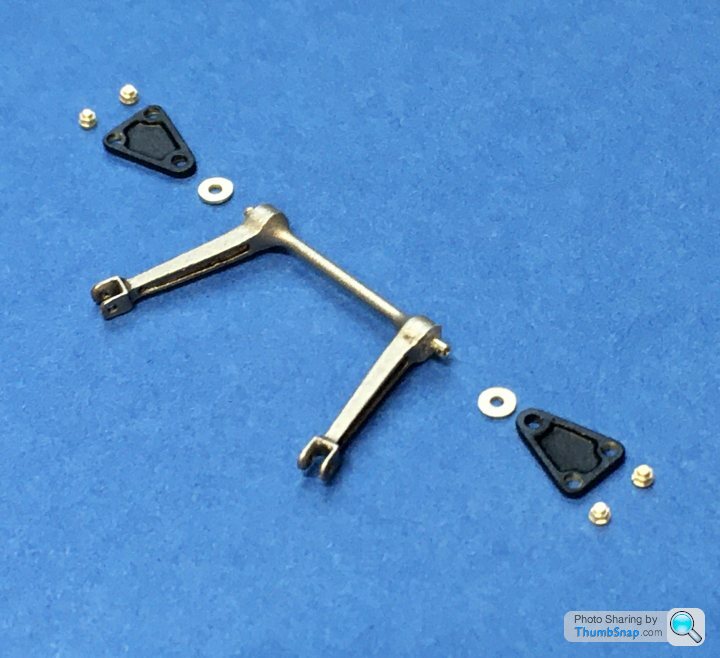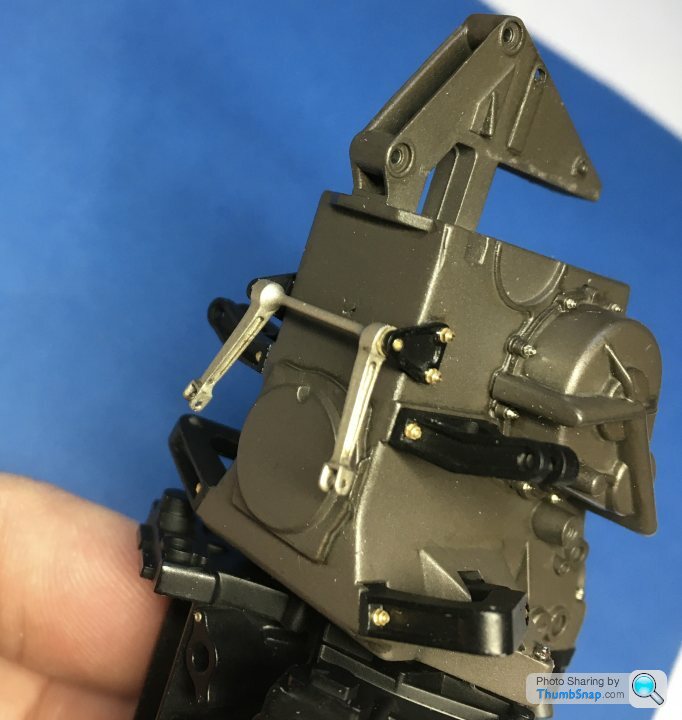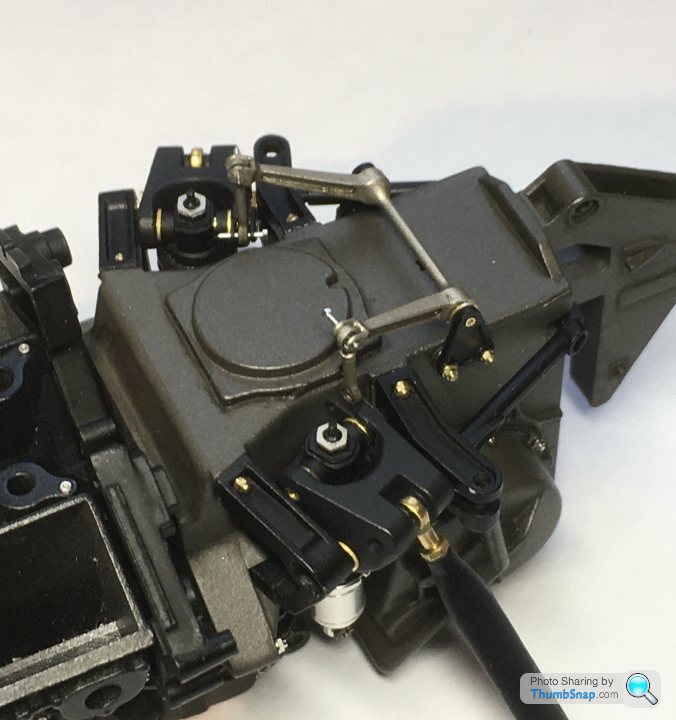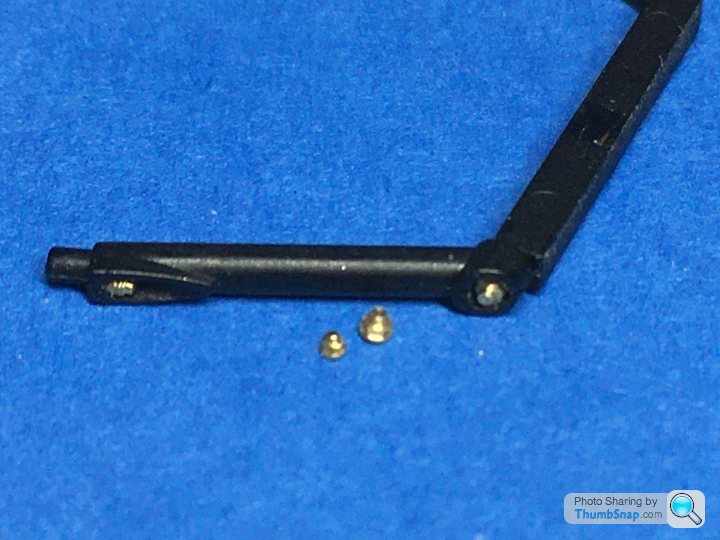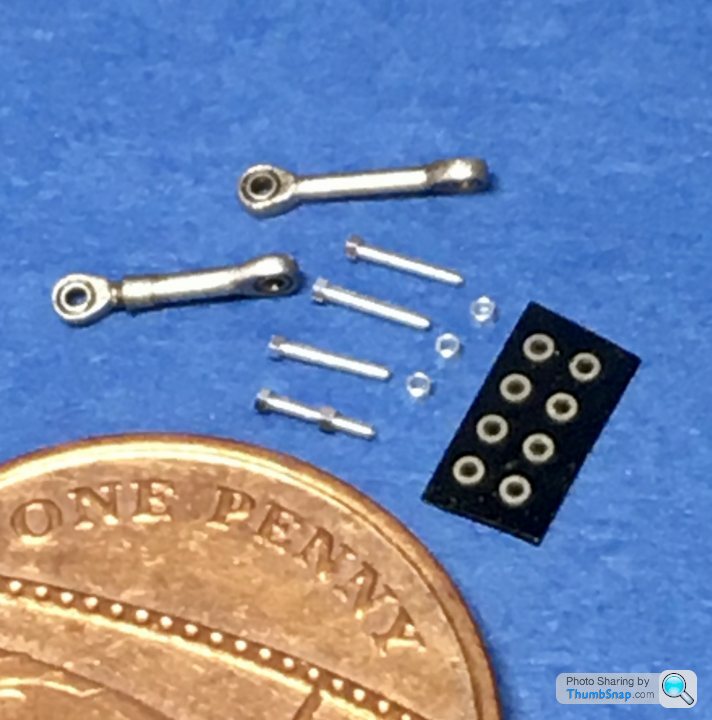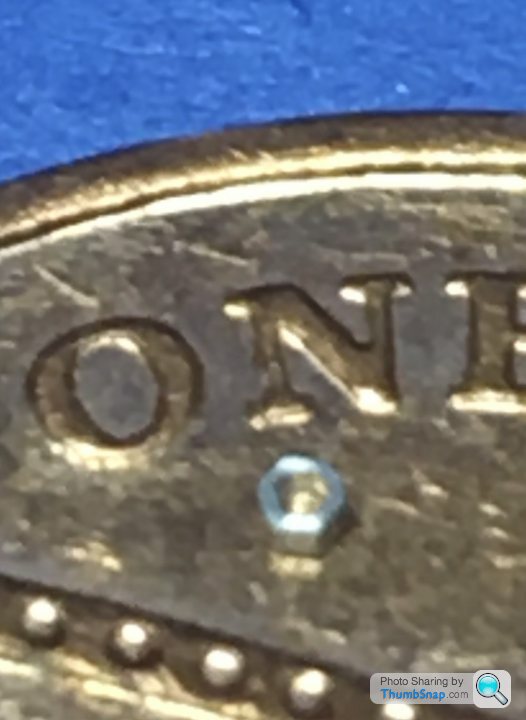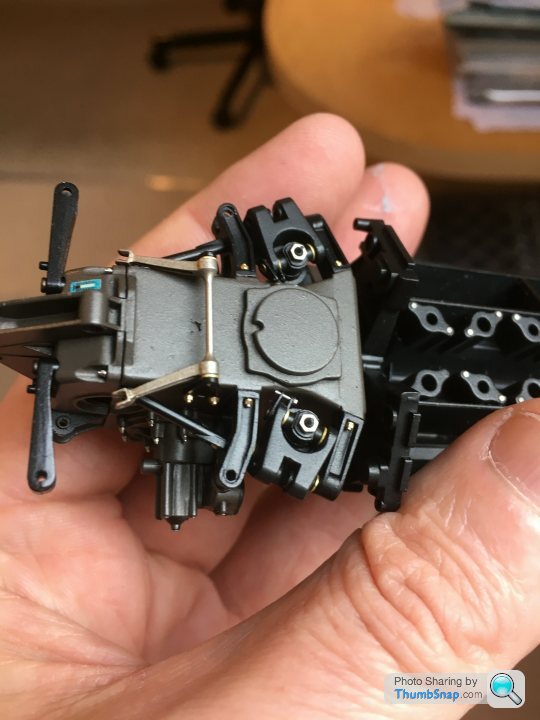Tamiya 1:12 McLaren MP4/6 Rebuild/Upgrade
Discussion
This is a slightly edited version of the post I made over on the F1M forum (images removed due to not having permission to reproduce them on another forum):
This information may be well known, maybe not. I thought I’d share it anyway, since it explains some features evident in many photographs of the MP4/6 tub:
I’m currently building the Tamiya 1:12 McLaren MP4/6, and have seen many methods of replicating the rough surface of its male-moulded tub. I’ve been putting off doing mine for several reasons, including:
• It’s difficult to find photographs which consistently show the surface detail of the real tub.
• Getting the correct colours is tricky, since they vary so much depending on lighting.
• Having rough tub sides exposed under the forward bodywork didn’t seem to ring true with McLaren’s reputation for attention to detail. I’ve seen these cars close-up in the pits in 1991, and others in the MP4/x series at historic racing events, and don’t remember noticing much inconsistency in external finish.
• There is little consistency in how the tub is represented in models.
I’ve recently got some clarifications to these points: I posted a series of my old ‘80’s & ‘90’s F1 photographs on a Facebook group dedicated to F1 Testing. Someone replied to one particular photograph of the MP4/5C, and it turned out to be Matthew Jeffreys. Matthew is a former Senior Design Engineer and Project Leader for chassis design at McLaren International. He was heavily involved in the design and manufacture of the MP4/6 chassis (and other McLaren cars of that era). Obviously I took the opportunity to ask a few questions...
To summarise, as is well known, the tub was formed using a male mould, which gave the distinctive rough/wrinkled outer surfaces. This however isn’t the full story: The vertical forward sides of the tub (those exposed to the airflow), were not rough, but in fact quite smooth. This also applied to the flat surface under the front dampers. These smooth surfaces were achieved by incorporating “caul plates” into the moulding process. The caul plates were sheets of smooth aluminium placed in contact with the outer surfaces of the tub in the appropriate places. Once cured, both the inner and outer surfaces of the tub were therefore smooth in these areas. In some images, reflections, combined with the translucence of the resin can make the sides look rougher than they are in reality.
The radii along the tub edges were rougher, since the caul plates didn’t extend around them. Where the edges of the front bodywork contacted the tub, strips of protective helicopter tape were applied. This gives rise to what at first glance appears to be an overlap of carbon sheets over the edge of the tub.
The caul plates extended to somewhere hidden behind the radiator ducts, because the entire visible area of the rear tub (ie behind the ducts) is rough - i.e. no caul plates.
The tub was made up of a patchwork of layers of unidirectional carbon fibre, and the tub colour is described by Matthew as “Dark Olive Drab”.
The radiator ducts were also male-moulded, but using a lower cure temperature resin. That’s why they are a different colour, described as “Dark Grey”.
The nose box was described as “Black” (I think this may be a plain or twill weave carbon).
When I asked about colours being affected by flash, the colours stated were described as “true colours”.
Just to confuse matters, some early development tubs had different caul plate arrangements, possibly having additional, locally applied plates on the angled parts of the tub for seating electrical boxes etc., so beware of relying 100% on photographs!
Hopefully the above will be of some use – I know I’m relieved that the amount of textured surfaces that need addressing has vastly reduced, although getting a realistic finish remains a huge challenge. I think if you look at photographs of other male-mould McLarens (eg the MP4/5x), you can, to an extent, work out how they were made and where the caul plates were used.
I'm very grateful to Matthew for taking the time to patiently answer my questions. I'll update this thread, should any further information become available.
Hope this might be of interest to anyone here on PH who'se building a '4/6 - or for general interest.
This information may be well known, maybe not. I thought I’d share it anyway, since it explains some features evident in many photographs of the MP4/6 tub:
I’m currently building the Tamiya 1:12 McLaren MP4/6, and have seen many methods of replicating the rough surface of its male-moulded tub. I’ve been putting off doing mine for several reasons, including:
• It’s difficult to find photographs which consistently show the surface detail of the real tub.
• Getting the correct colours is tricky, since they vary so much depending on lighting.
• Having rough tub sides exposed under the forward bodywork didn’t seem to ring true with McLaren’s reputation for attention to detail. I’ve seen these cars close-up in the pits in 1991, and others in the MP4/x series at historic racing events, and don’t remember noticing much inconsistency in external finish.
• There is little consistency in how the tub is represented in models.
I’ve recently got some clarifications to these points: I posted a series of my old ‘80’s & ‘90’s F1 photographs on a Facebook group dedicated to F1 Testing. Someone replied to one particular photograph of the MP4/5C, and it turned out to be Matthew Jeffreys. Matthew is a former Senior Design Engineer and Project Leader for chassis design at McLaren International. He was heavily involved in the design and manufacture of the MP4/6 chassis (and other McLaren cars of that era). Obviously I took the opportunity to ask a few questions...
To summarise, as is well known, the tub was formed using a male mould, which gave the distinctive rough/wrinkled outer surfaces. This however isn’t the full story: The vertical forward sides of the tub (those exposed to the airflow), were not rough, but in fact quite smooth. This also applied to the flat surface under the front dampers. These smooth surfaces were achieved by incorporating “caul plates” into the moulding process. The caul plates were sheets of smooth aluminium placed in contact with the outer surfaces of the tub in the appropriate places. Once cured, both the inner and outer surfaces of the tub were therefore smooth in these areas. In some images, reflections, combined with the translucence of the resin can make the sides look rougher than they are in reality.
The radii along the tub edges were rougher, since the caul plates didn’t extend around them. Where the edges of the front bodywork contacted the tub, strips of protective helicopter tape were applied. This gives rise to what at first glance appears to be an overlap of carbon sheets over the edge of the tub.
The caul plates extended to somewhere hidden behind the radiator ducts, because the entire visible area of the rear tub (ie behind the ducts) is rough - i.e. no caul plates.
The tub was made up of a patchwork of layers of unidirectional carbon fibre, and the tub colour is described by Matthew as “Dark Olive Drab”.
The radiator ducts were also male-moulded, but using a lower cure temperature resin. That’s why they are a different colour, described as “Dark Grey”.
The nose box was described as “Black” (I think this may be a plain or twill weave carbon).
When I asked about colours being affected by flash, the colours stated were described as “true colours”.
Just to confuse matters, some early development tubs had different caul plate arrangements, possibly having additional, locally applied plates on the angled parts of the tub for seating electrical boxes etc., so beware of relying 100% on photographs!
Hopefully the above will be of some use – I know I’m relieved that the amount of textured surfaces that need addressing has vastly reduced, although getting a realistic finish remains a huge challenge. I think if you look at photographs of other male-mould McLarens (eg the MP4/5x), you can, to an extent, work out how they were made and where the caul plates were used.
I'm very grateful to Matthew for taking the time to patiently answer my questions. I'll update this thread, should any further information become available.
Hope this might be of interest to anyone here on PH who'se building a '4/6 - or for general interest.
I left this one back in August because I couldn’t find a satin varnish I was happy with. I managed to find some Mr.Hobby Aqueous online, which arrived the other day:
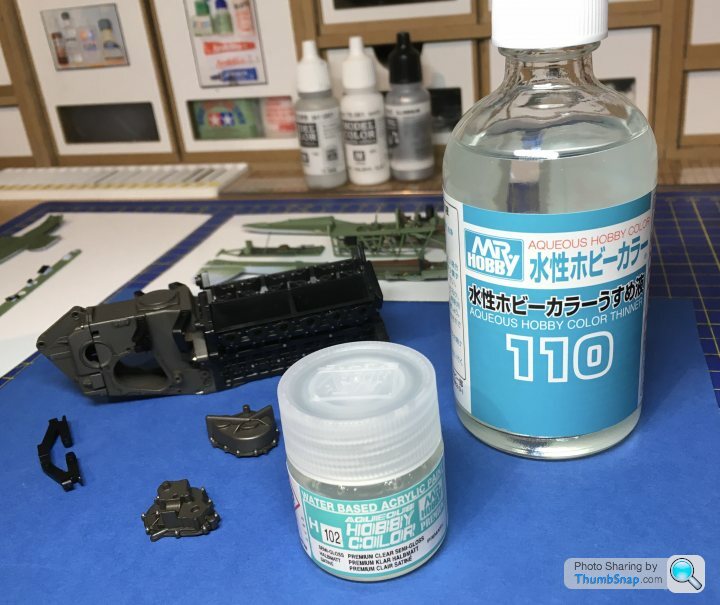
Having spent a long time on the Airfix Swordfish, I was keen to get back to this one. Strange thing is, now I look at the finish I wasn’t happy about, it looks fine:
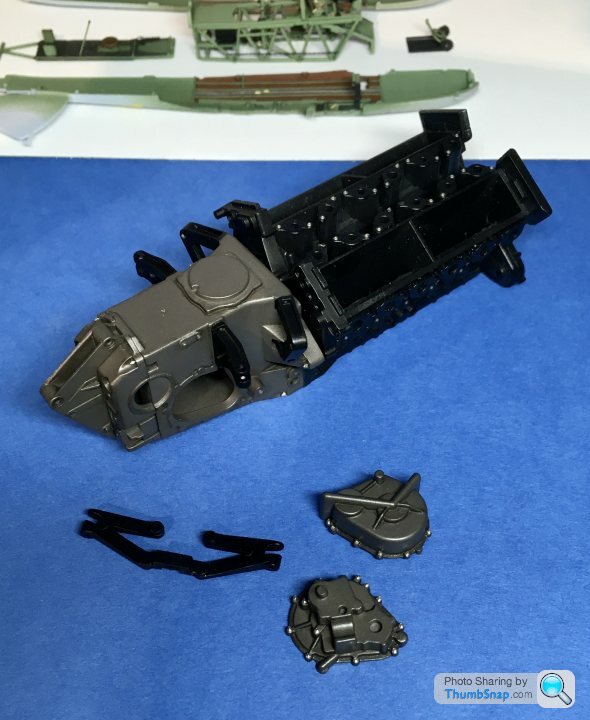
Not sure whether the old satin varnish needed a long time to dry, or whether I was being over critical, or whether I’m just going senile. Anyway, hopefully I’ll be able to complete the engine and transmission now...

Having spent a long time on the Airfix Swordfish, I was keen to get back to this one. Strange thing is, now I look at the finish I wasn’t happy about, it looks fine:

Not sure whether the old satin varnish needed a long time to dry, or whether I was being over critical, or whether I’m just going senile. Anyway, hopefully I’ll be able to complete the engine and transmission now...
Thanks both!
So enough’s enough. Today come what may I wanted to do something to move this millstone forward a bit. This is where I left the modified rear rockers, with the unpainted, scratch built bits. I hesitate to say “corrected”, but they are far closer to reality than the kit/Top Studio parts:
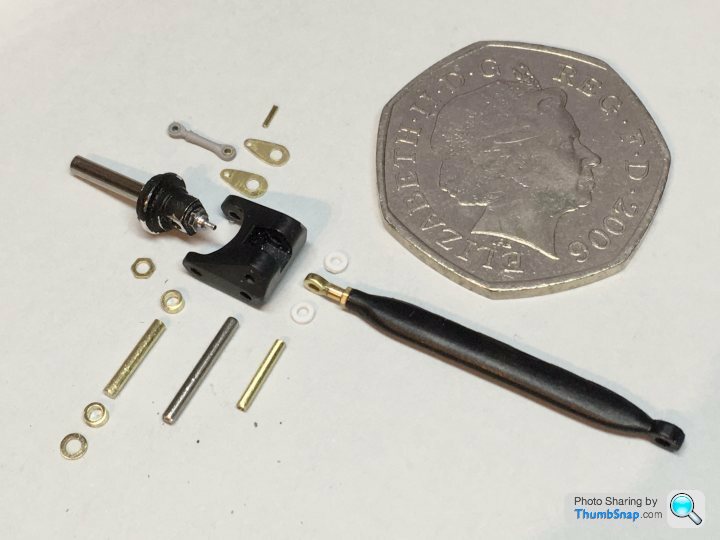
So once the relevant bits were painted and satin coated, assembly was pretty straightforward. Springs are too thin, but easily fixed later if I can source some more realistic items:
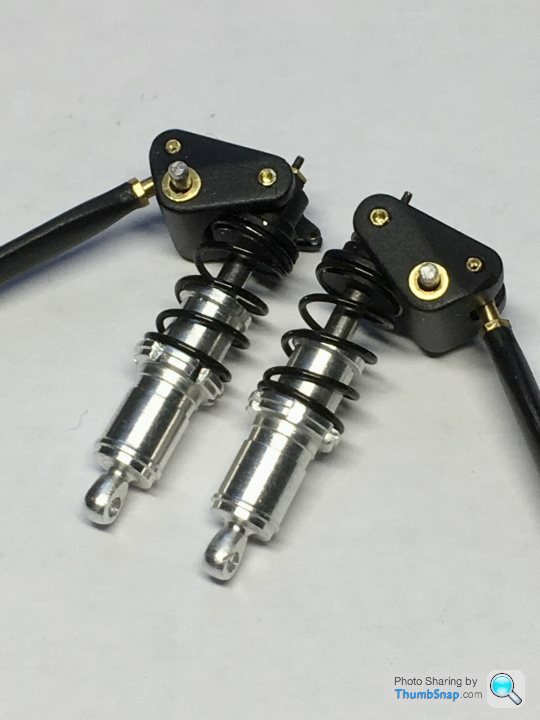
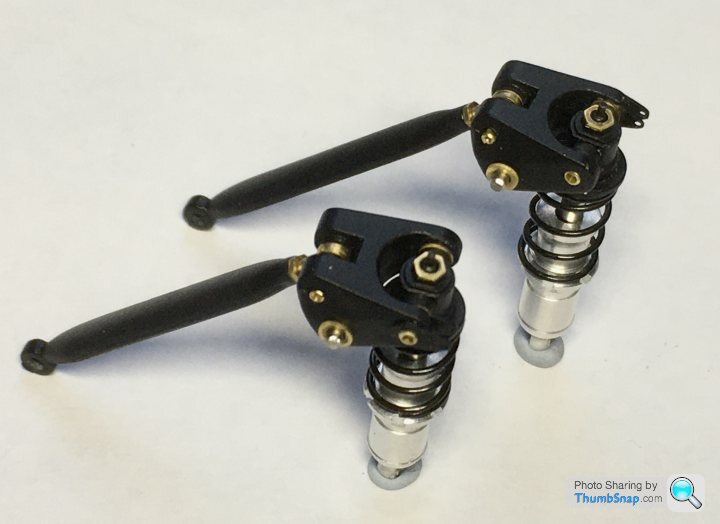
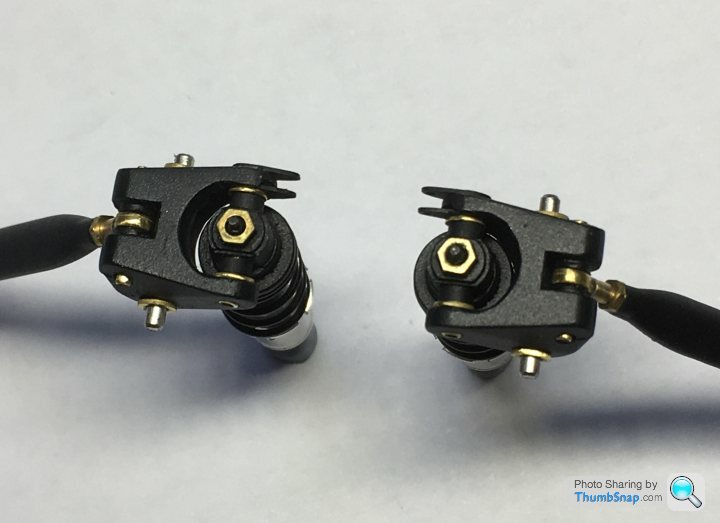
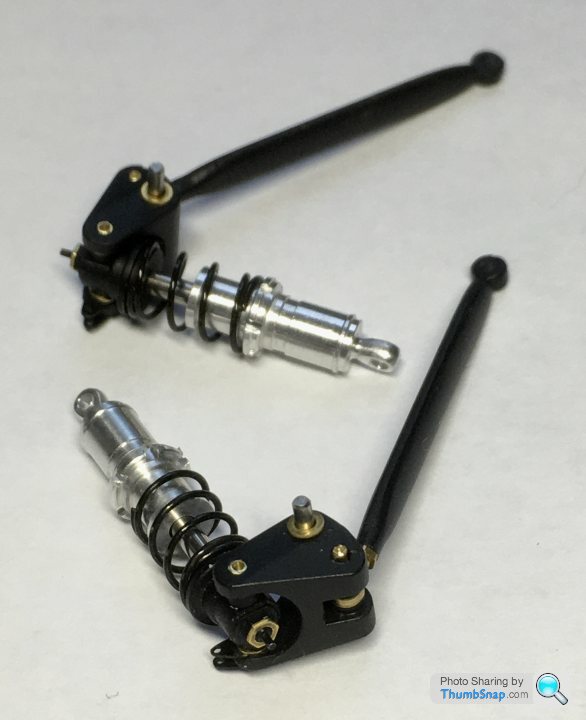
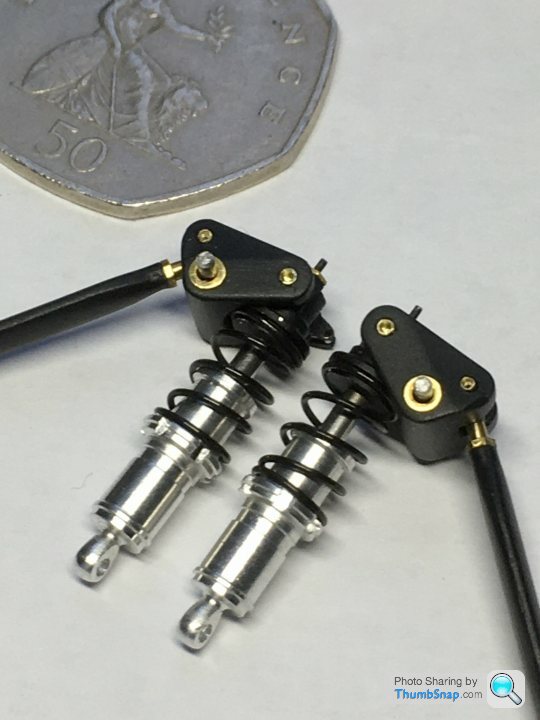
Then on to the gearbox casings, which I fitted with PVA - just in case...
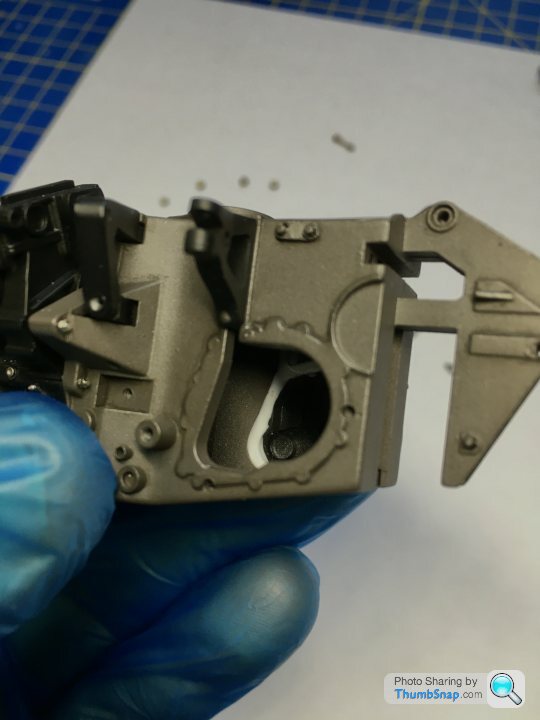
I ended up getting some Top Studio brass fasteners for the suspension brackets - I think the real ones may have had a gold coating:
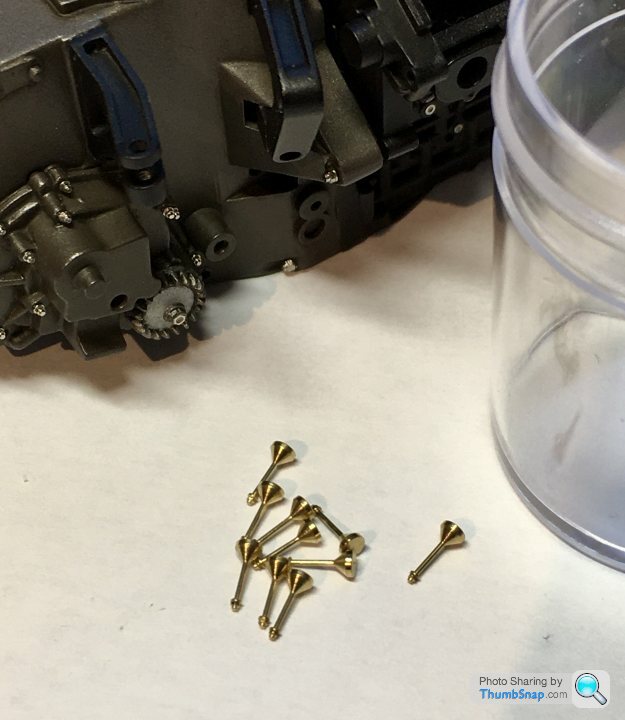
You can cut them to whatever size you need:
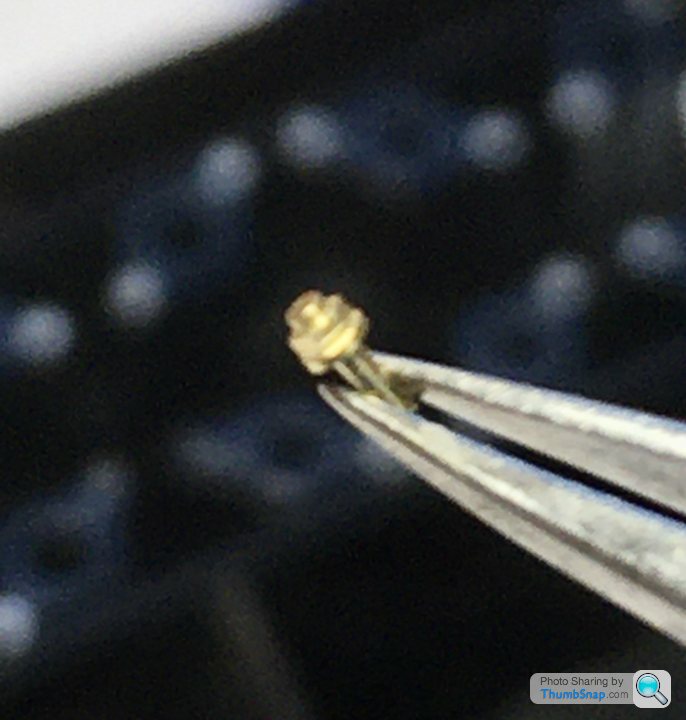
Here they are fitted:
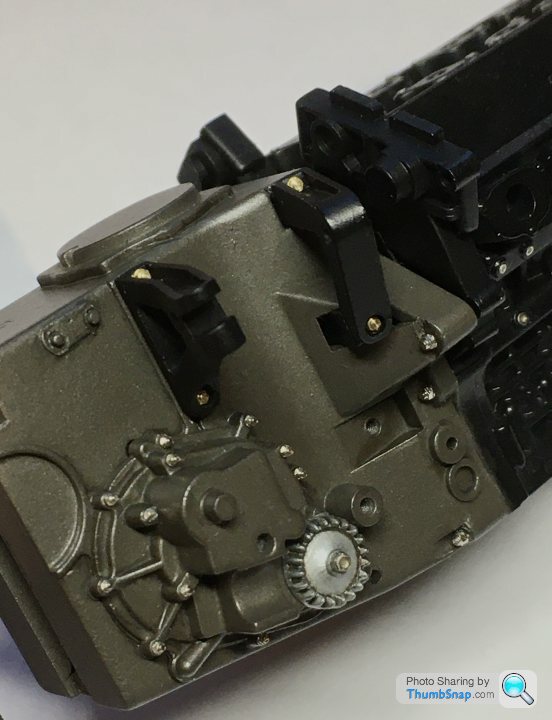
So far so good. Next job will be to give the other gearbox and suspension mounts a coat of Mr.Hobby Aqueous satin, and get the rest of the gearbox assembled.
So enough’s enough. Today come what may I wanted to do something to move this millstone forward a bit. This is where I left the modified rear rockers, with the unpainted, scratch built bits. I hesitate to say “corrected”, but they are far closer to reality than the kit/Top Studio parts:

So once the relevant bits were painted and satin coated, assembly was pretty straightforward. Springs are too thin, but easily fixed later if I can source some more realistic items:





Then on to the gearbox casings, which I fitted with PVA - just in case...

I ended up getting some Top Studio brass fasteners for the suspension brackets - I think the real ones may have had a gold coating:

You can cut them to whatever size you need:

Here they are fitted:

So far so good. Next job will be to give the other gearbox and suspension mounts a coat of Mr.Hobby Aqueous satin, and get the rest of the gearbox assembled.
Edited by dr_gn on Sunday 27th December 16:20
ChevronB19 said:
I tend to build 1:48 planes due to general clumsiness, and wish I had the skill (and patience) to do something like this, but I have to ask: how on Earth to you glue things that small without leaving either big smudges of glue everywhere or getting an insufficient bond?
It depends on the part. For the black triangular a.r.b. plate to gearbox join I used Araldite, because it needs to be fairly rigid. I apply it with fuse wire. It’s wasteful because there’s a limit to how much you can mix accurately in tiny amounts.For the non-structural and smaller stuff like bolts and bolt heads I invariably use PVA. It’s easily strong enough for small parts, can be diluted with water to wick into places you can’t accurately get to, and of course if you use the right type, it can be re-dissolved if you screw up. The other big advantage is that it’s pretty much invisible once set.
NotNormal said:
In awe every time I see the updates on this thread. Amazing skill and keep up the good work 
Thanks for the encouragement! This one is taking its toll - nothing seems to fit without some fettling, and fettling invariably means damaging paint somewhere or other. It’s a viscious circle. and experimenting with matt/satin varnish is a pain. 
Anyway, I decided to test assemble what I’ve got so far, just to make sure it fits before going any further. The modified rocker geometry looks way better than the original kit, and the a.r.b. mounts and linkages are now pretty accurate:
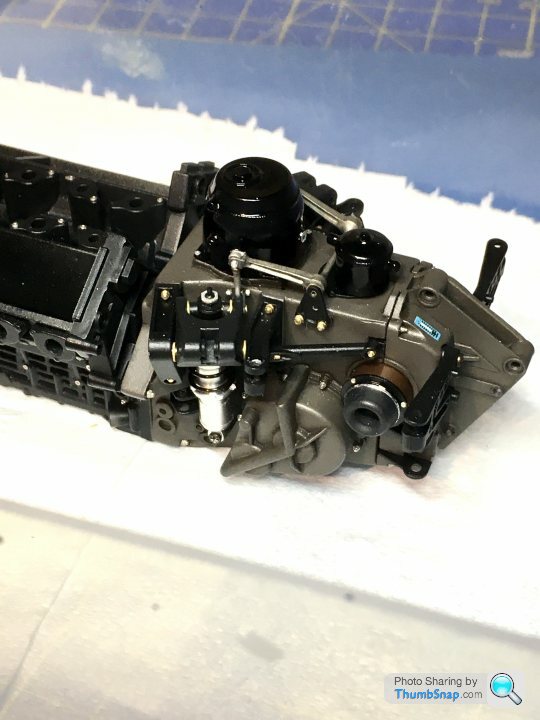
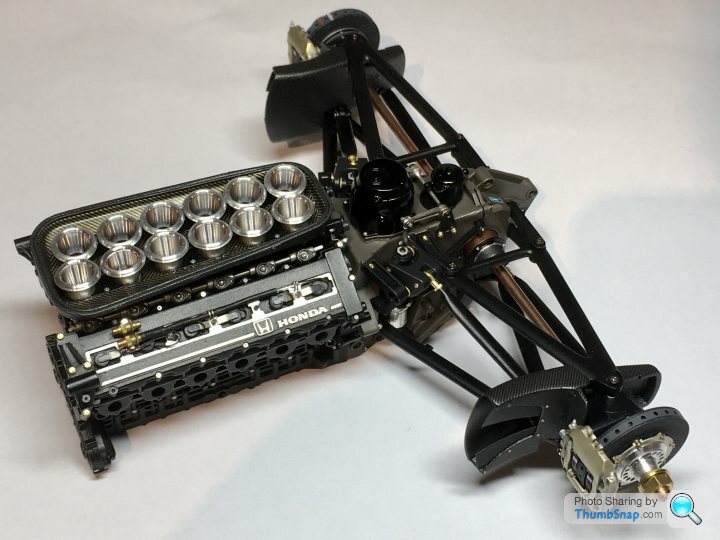
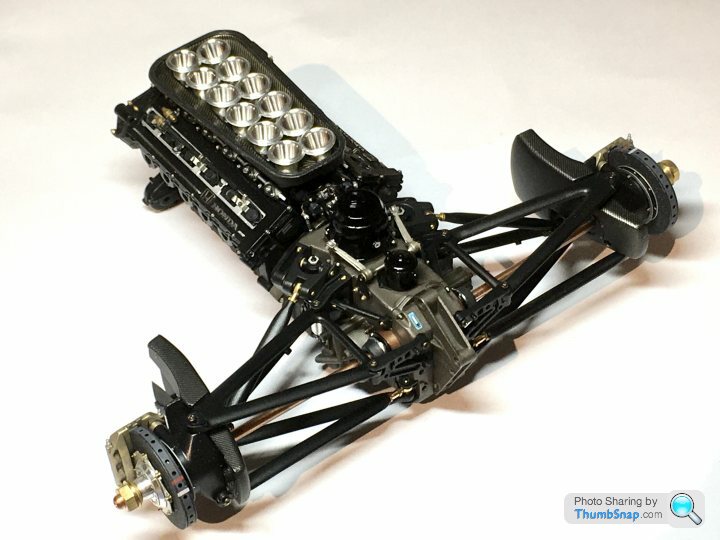
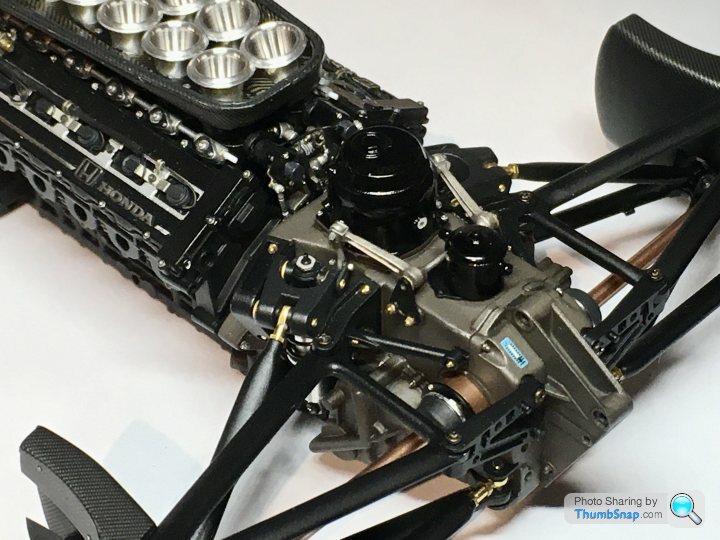
I kind of wish I’d not satined the fasteners - they look a bit dull now, then again previously they were a bit too bling. Anyway, it is what it is.
Still needs all the wiring, hoses and anodised fittings, and the gold coloured suspension arm bolts. Before that though, the upper wishbones need their camber shims dealing with.
matc said:
It looks stunning; will be a shame to cover it with a body! Keep the updates coming - may admiration for your patience and craftsmanship is huge!
Too kind - thanks! This is the chassis version which won't have the body on at all. I've got my original model, which I am re-building as "kerbside". They will be displayed together on a base, along with my Senna and Berger autographs. The FW14B and Ferrari 641 will just be single chassis with the body displayed alongside though. That's if I have enough years left to complete them.robemcdonald said:
I came across the pictures on the link below and immediately thought of this build.
https://www.ultimatecarpage.com/img/McLaren-MP4-6-...
You have probably seen them before, but if hope they provide a useful reference.
Thanks for that. Yes I've got that bookmarked already. There are some useful references, but some of the engine bay and tub hardware is slightly different from back in the day. I think the images are from the Goodwood FoS fairly recently.https://www.ultimatecarpage.com/img/McLaren-MP4-6-...
You have probably seen them before, but if hope they provide a useful reference.
Bobkshea said:
Long time looker first time poster…
Wondering what happened to Doc’s amazing build? Is the big fella just back to work post lockdowns?
I recently jumped on the exact model and TS full detail kit… hope to start soon!
Oh no I’d forgotten about that one…Wondering what happened to Doc’s amazing build? Is the big fella just back to work post lockdowns?
I recently jumped on the exact model and TS full detail kit… hope to start soon!
I got stuck on the rear anti-roll bar not looking right, and also not being sure how to represent the male-mould tub.
The resin printer will solve the first issue, but the second still puzzles me.
Gassing Station | Scale Models | Top of Page | What's New | My Stuff




